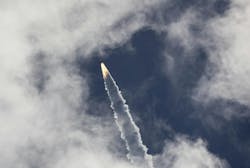Despite New Leaks Since Launch, Boeing’s Starliner Headed for Space Station Rendezvous
Boeing’s Starliner sprung two new leaks in its propulsion system after launch from Cape Canaveral on Wednesday, but NASA has told its two NASA astronauts on board that it’s safe to proceed with planned docking at the International Space Station today.
Barry “Butch” Wilmore and Sunita “Suni” Williams are flying the Crew Flight Test mission that marks Starliner’s first human spaceflight. They awoke at 4:30 a.m. asking for an update after teams identified hours after launch two more helium leaks on top of one that was already known of before launch.
“Actually, umm, we’re kind of curious where we stand as far as our leaks. If we could get a summary on that, that would be wonderful,” Wilmore said.
Two of the valves were closed with the spacecraft remaining stable, according to NASA.
“Regarding the leaks we spoke of last night, the big picture is the current leak rates are, we are going to be able to support a rendezvous today with that,” replied the NASA capsule communications officer Rob Hayhurst from Houston.
NASA said the propellant team is working to increase pressure on parts of the propulsion system so the NASA astronauts would have adequate use of the engine jets to perform the planned test maneuvers before docking, but teams with NASA and Boeing will review data before the approach.
The helium leak that was known of before launch was the subject of several days of delay as teams determined the safety to the astronauts even if the leak got worse. Teams also worked through potential landing procedures if leaks were to spring up on more of the engines on the propulsion module to ensure Starliner could make it back to Earth.
Boeing’s Starliner launches on historic 1st human spaceflight for NASA
Their arrival slated for 12:15 p.m. would come more than 25 hours after launching from Cape Canaveral Space Force Station atop a United Launch Alliance Atlas V rocket.
The ISS population will temporarily go up to nine as Wilmore and Williams join the seven members of Expedition 71. That includes the four members of SpaceX’s Crew-8 that flew up to the station in February on the Crew Dragon Endeavour.
“I’m really looking forward to seeing two U.S. vehicles at the International Space Station,” said Ken Bowersox, the associate administrator for NASA’s Space Operations Mission Directorate during a post-launch press conference Wednesday. “I know Butch and Suni will probably get a kick out of that, if they get a chance, to look out the windows and see a Dragon there, see a Starliner there. It’s something that I think all of us should be proud of.”
The point of the CFT mission is so Boeing can join SpaceX as one of two companies providing regular ferry service to and from the ISS under NASA’s Commercial Crew Program, something meant to end NASA’s reliance on Russia’s Soyuz flights after the end of the Space Shuttle Program in 2011.
SpaceX achieved that first beginning in May 2020, and has been handling the U.S.-based launches for that program for four years already having flown its fleet of Crew Dragon spacecraft 13 times carrying 50 humans to space.
Boeing, now, though, looks to complete the CFT so Starliner can be certified for its contracted six rotational missions to the ISS that could begin as early as February 2025.
“Launch is just the first part of this,” said Boeing’s Mark Nappi, the company’s commercial crew program lead. “We now have to get to ISS, we have to dock, we have to do docking opps, we have to undock, we have to do reentry and we have to land. So each one of those phases we’re going to really pay very, very close attention to and our team is really focused on that.”
Wilmore and Williams took care of some of the test flight agenda items on the flight up to the ISS including trying out some manual control overrides for what is supposed to be a mostly automated spacecraft. While on board, they will also make sure Starliner can act as a lifeboat for a full ISS crew in case of an issue with the space station. And they will try out more manual maneuvers on the return home.
Plans will keep them docked to the ISS for about eight days, and the return flight will have them make a desert landing in one of five predetermined sites in the southwestern United States.
“This is a test flight,” Nappi said. “We’re going to probably experience a few things that we’ve got to go look into, and we’ll do that and we’ll talk to you about them as time goes on. But we’re going to learn from this, and we’re going to have a great experience. We’re on orbit with Butch and Suni, and it’s been a long time coming and we’re really, really proud of the team that got us here.”
©2024 Orlando Sentinel. Visit orlandosentinel.com. Distributed by Tribune Content Agency, LLC.
